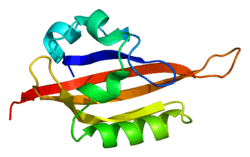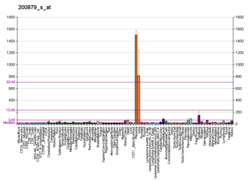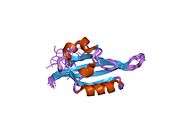EPAS1
Endothelial PAS domain-containing protein 1 (EPAS1, also known as hypoxia-inducible factor-2alpha (HIF-2alpha)) is a protein that in humans is encoded by the EPAS1 gene. It is a type of hypoxia-inducible factor, a group of transcription factors involved in body response to oxygen level.[5][6][7][8] The gene is active under low oxygen condition called hypoxia. It is also important in the development of the heart, and maintaining catecholamine balance required for protection of the heart. Mutation often leads to neuroendocrine tumors.
However, a special version (allele) of EPAS1 produces EPAS1 which is responsible for high-altitude adaptation in humans.[9][10] It is known that the variant gene confers increased athletic performance in some people, and hence it is dubbed the "super athlete gene".[11]
Function
The EPAS1 gene encodes half of a transcription factor involved in the induction of genes regulated by oxygen, which is induced as oxygen levels fall (hypoxia). The encoded protein contains a basic helix-loop-helix domain protein dimerization domain as well as a domain found in proteins in signal transduction pathways which respond to oxygen levels. EPAS 1 is involved in the development of the embryonic heart and is expressed in the endothelial cells that line the walls of the blood vessels in the umbilical cord. It is essential in maintaining catecholamine homeostasis and protection against heart failure during early embryonic development.[8]
Catecholamines include epinephrine and norepinephrine. It is important for the production of catecholamines to remain in homeostatic conditions so that both the delicate fetal heart and the adult heart do not overexert themselves and induce heart failure. Catecholamine production in the embryo is related to control of cardiac output by increasing the fetal heart rate.[12]
Alleles
Tibetans carry a high proportion of an allele that improves oxygen transport. The beneficial allele is also found in the extinct Denisovan genome, suggesting that it arose in them and entered the modern human population by hybridization.[13]
The Tibetan Mastiff also received a variant of the allele by interbreeding with the native Tibetan wolf.[14]
Clinical significance
Mutations in EPAS1 gene are related to early onset of neuroendocrine tumors such as paragangliomas, somatostatinomas and/or pheochromocytomas. The mutations are commonly somatic missense mutations that locate in the primary hydroxylation site of HIF-2α, which disrupt the protein hydroxylation/degradation mechanism, and leads to protein stabilization and pseudohypoxic signaling. In addition, these neuroendocrine tumors release erythropoietin (EPO) into circulating blood, and lead to polycythemia.[15][16]
Mutations in this gene are associated with erythrocytosis familial type 4,[8] pulmonary hypertension and chronic mountain sickness.[17] There is also evidence that certain variants of this gene provide protection for people living at high altitude such as in Tibet.[9][10][18] The effect is most profound among the Tibetans living in the Himalayas at an altitude of about 4,000 metres above sea level, the environment of which is intolerable to other human populations due to 40% less atmospheric oxygen. The Tibetans suffer no health problems associated with altitude sickness, but instead produce low levels of blood pigment (haemoglobin) sufficient for less oxygen, more elaborate blood vessels,[19] have lower infant mortality,[20] and are heavier at birth.[21]
EPAS1 is useful in high altitudes as a short term adaptive response. However, EPAS1 can also cause excessive production of red blood cells leading to chronic mountain sickness that can lead to death and inhibited reproductive abilities. Some mutations that increase its expression are associated with increased hypertension and stroke at low altitude, with symptoms similar to mountain sickness. People permanently living at high altitudes might experience selection of EPAS1 to reduce the fitness consequences of excessive red blood cell production.[18]
Interactions
EPAS1 has been shown to interact with aryl hydrocarbon receptor nuclear translocator[22] and ARNTL.[23]
References
- 1 2 3 GRCh38: Ensembl release 89: ENSG00000116016 - Ensembl, May 2017
- 1 2 3 GRCm38: Ensembl release 89: ENSMUSG00000024140 - Ensembl, May 2017
- ↑ "Human PubMed Reference:".
- ↑ "Mouse PubMed Reference:".
- ↑ Tian H, McKnight SL, Russell DW (January 1997). "Endothelial PAS domain protein 1 (EPAS1), a transcription factor selectively expressed in endothelial cells". Genes & Development. 11 (1): 72–82. doi:10.1101/gad.11.1.72. PMID 9000051.
- ↑ Hogenesch JB, Chan WK, Jackiw VH, Brown RC, Gu YZ, Pray-Grant M, Perdew GH, Bradfield CA (March 1997). "Characterization of a subset of the basic-helix-loop-helix-PAS superfamily that interacts with components of the dioxin signaling pathway". The Journal of Biological Chemistry. 272 (13): 8581–93. doi:10.1074/jbc.272.13.8581. PMID 9079689.
- ↑ Percy MJ, Beer PA, Campbell G, Dekker AW, Green AR, Oscier D, Rainey MG, van Wijk R, Wood M, Lappin TR, McMullin MF, Lee FS (June 2008). "Novel exon 12 mutations in the HIF2A gene associated with erythrocytosis". Blood. 111 (11): 5400–2. doi:10.1182/blood-2008-02-137703. PMC 2396730. PMID 18378852.
- 1 2 3 "Entrez Gene: EPAS1 endothelial PAS domain protein 1".
- 1 2 Yi X, Liang Y, Huerta-Sanchez E, Jin X, Cuo ZX, Pool JE, Xu X, Jiang H, Vinckenbosch N, Korneliussen TS, Zheng H, Liu T, He W, Li K, Luo R, Nie X, Wu H, Zhao M, Cao H, Zou J, Shan Y, Li S, Yang Q, Ni P, Tian G, Xu J, Liu X, Jiang T, Wu R, Zhou G, Tang M, Qin J, Wang T, Feng S, Li G, Luosang J, Wang W, Chen F, Wang Y, Zheng X, Li Z, Bianba Z, Yang G, Wang X, Tang S, Gao G, Chen Y, Luo Z, Gusang L, Cao Z, Zhang Q, Ouyang W, Ren X, Liang H, Zheng H, Huang Y, Li J, Bolund L, Kristiansen K, Li Y, Zhang Y, Zhang X, Li R, Li S, Yang H, Nielsen R, Wang J, Wang J (July 2010). "Sequencing of 50 human exomes reveals adaptation to high altitude". Science. 329 (5987): 75–8. doi:10.1126/science.1190371. PMC 3711608. PMID 20595611.
- 1 2 Hanaoka M, Droma Y, Basnyat B, Ito M, Kobayashi N, Katsuyama Y, Kubo K, Ota M (2012). "Genetic variants in EPAS1 contribute to adaptation to high-altitude hypoxia in Sherpas". PLoS One. 7 (12): e50566. doi:10.1371/journal.pone.0050566. PMC 3515610. PMID 23227185.
- ↑ Algar, Jim (1 July 2014). "Tibetan 'super athlete' gene courtesy of an extinct human species". Tech Times. Retrieved 22 July 2014.
- ↑ Tian H, Hammer RE, Matsumoto AM, Russell DW, McKnight SL (November 1998). "The hypoxia-responsive transcription factor EPAS1 is essential for catecholamine homeostasis and protection against heart failure during embryonic development". Genes & Development. 12 (21): 3320–4. doi:10.1101/gad.12.21.3320. PMC 317225. PMID 9808618.
- ↑ Jeong C, Alkorta-Aranburu G, Basnyat B, Neupane M, Witonsky DB, Pritchard JK, Beall CM, Di Rienzo A (2014-02-10). "Admixture facilitates genetic adaptations to high altitude in Tibet". Nature Communications. 5: 3281. doi:10.1038/ncomms4281. PMID 24513612.
- ↑ Miao B, Wang Z, Li Y (December 2016). "Genomic Analysis Reveals Hypoxia Adaptation in the Tibetan Mastiff by Introgression of the Grey Wolf from the Tibetan Plateau". Molecular Biology and Evolution. doi:10.1093/molbev/msw274. PMID 27927792.
- ↑ Zhuang Z, Yang C, Lorenzo F, Merino M, Fojo T, Kebebew E, Popovic V, Stratakis CA, Prchal JT, Pacak K (September 2012). "Somatic HIF2A gain-of-function mutations in paraganglioma with polycythemia". The New England Journal of Medicine. 367 (10): 922–30. doi:10.1056/NEJMoa1205119. PMC 3432945. PMID 22931260.
- ↑ Yang C, Sun MG, Matro J, Huynh TT, Rahimpour S, Prchal JT, Lechan R, Lonser R, Pacak K, Zhuang Z (March 2013). "Novel HIF2A mutations disrupt oxygen sensing, leading to polycythemia, paragangliomas, and somatostatinomas". Blood. 121 (13): 2563–6. doi:10.1182/blood-2012-10-460972. PMC 3612863. PMID 23361906.
- ↑ Gale DP, Harten SK, Reid CD, Tuddenham EG, Maxwell PH (August 2008). "Autosomal dominant erythrocytosis and pulmonary arterial hypertension associated with an activating HIF2 alpha mutation". Blood. 112 (3): 919–21. doi:10.1182/blood-2008-04-153718. PMID 18650473.
- 1 2 Beall CM, Cavalleri GL, Deng L, Elston RC, Gao Y, Knight J, Li C, Li JC, Liang Y, McCormack M, Montgomery HE, Pan H, Robbins PA, Shianna KV, Tam SC, Tsering N, Veeramah KR, Wang W, Wangdui P, Weale ME, Xu Y, Xu Z, Yang L, Zaman MJ, Zeng C, Zhang L, Zhang X, Zhaxi P, Zheng YT (June 2010). "Natural selection on EPAS1 (HIF2alpha) associated with low hemoglobin concentration in Tibetan highlanders". Proceedings of the National Academy of Sciences of the United States of America. 107 (25): 11459–64. doi:10.1073/pnas.1002443107. PMC 2895075. PMID 20534544.
- ↑ Beall CM (February 2006). "Andean, Tibetan, and Ethiopian patterns of adaptation to high-altitude hypoxia". Integrative and Comparative Biology. 46 (1): 18–24. doi:10.1093/icb/icj004. PMID 21672719.
- ↑ Beall CM, Song K, Elston RC, Goldstein MC (September 2004). "Higher offspring survival among Tibetan women with high oxygen saturation genotypes residing at 4,000 m". Proceedings of the National Academy of Sciences of the United States of America. 101 (39): 14300–4. doi:10.1073/pnas.0405949101. PMC 521103. PMID 15353580.
- ↑ Beall CM (May 2007). "Two routes to functional adaptation: Tibetan and Andean high-altitude natives". Proceedings of the National Academy of Sciences of the United States of America. 104 Suppl 1: 8655–60. doi:10.1073/pnas.0701985104. PMC 1876443. PMID 17494744.
- ↑ Hogenesch JB, Chan WK, Jackiw VH, Brown RC, Gu YZ, Pray-Grant M, Perdew GH, Bradfield CA (March 1997). "Characterization of a subset of the basic-helix-loop-helix-PAS superfamily that interacts with components of the dioxin signaling pathway". The Journal of Biological Chemistry. 272 (13): 8581–93. doi:10.1074/jbc.272.13.8581. PMID 9079689.
- ↑ Hogenesch JB, Gu YZ, Jain S, Bradfield CA (May 1998). "The basic-helix-loop-helix-PAS orphan MOP3 forms transcriptionally active complexes with circadian and hypoxia factors". Proceedings of the National Academy of Sciences of the United States of America. 95 (10): 5474–9. doi:10.1073/pnas.95.10.5474. PMC 20401. PMID 9576906.
Further reading
- Brahimi-Horn MC, Pouysségur J (2005). "The hypoxia-inducible factor and tumor progression along the angiogenic pathway". International Review of Cytology. 242: 157–213. doi:10.1016/S0074-7696(04)42004-X. PMID 15598469.
- Haase VH (August 2006). "Hypoxia-inducible factors in the kidney". American Journal of Physiology. Renal Physiology. 291 (2): F271–81. doi:10.1152/ajprenal.00071.2006. PMC 4232221. PMID 16554418.
- Andersson B, Wentland MA, Ricafrente JY, Liu W, Gibbs RA (April 1996). "A "double adaptor" method for improved shotgun library construction". Analytical Biochemistry. 236 (1): 107–13. doi:10.1006/abio.1996.0138. PMID 8619474.
- Yu W, Andersson B, Worley KC, Muzny DM, Ding Y, Liu W, Ricafrente JY, Wentland MA, Lennon G, Gibbs RA (April 1997). "Large-scale concatenation cDNA sequencing". Genome Research. 7 (4): 353–8. doi:10.1101/gr.7.4.353. PMC 139146. PMID 9110174.
- Ema M, Taya S, Yokotani N, Sogawa K, Matsuda Y, Fujii-Kuriyama Y (April 1997). "A novel bHLH-PAS factor with close sequence similarity to hypoxia-inducible factor 1alpha regulates the VEGF expression and is potentially involved in lung and vascular development". Proceedings of the National Academy of Sciences of the United States of America. 94 (9): 4273–8. doi:10.1073/pnas.94.9.4273. PMC 20712. PMID 9113979.
- Hogenesch JB, Gu YZ, Jain S, Bradfield CA (May 1998). "The basic-helix-loop-helix-PAS orphan MOP3 forms transcriptionally active complexes with circadian and hypoxia factors". Proceedings of the National Academy of Sciences of the United States of America. 95 (10): 5474–9. doi:10.1073/pnas.95.10.5474. PMC 20401. PMID 9576906.
- Takahata S, Sogawa K, Kobayashi A, Ema M, Mimura J, Ozaki N, Fujii-Kuriyama Y (July 1998). "Transcriptionally active heterodimer formation of an Arnt-like PAS protein, Arnt3, with HIF-1a, HLF, and clock". Biochemical and Biophysical Research Communications. 248 (3): 789–94. doi:10.1006/bbrc.1998.9012. PMID 9704006.
- Ema M, Hirota K, Mimura J, Abe H, Yodoi J, Sogawa K, Poellinger L, Fujii-Kuriyama Y (April 1999). "Molecular mechanisms of transcription activation by HLF and HIF1alpha in response to hypoxia: their stabilization and redox signal-induced interaction with CBP/p300". The EMBO Journal. 18 (7): 1905–14. doi:10.1093/emboj/18.7.1905. PMC 1171276. PMID 10202154.
- Cockman ME, Masson N, Mole DR, Jaakkola P, Chang GW, Clifford SC, Maher ER, Pugh CW, Ratcliffe PJ, Maxwell PH (August 2000). "Hypoxia inducible factor-alpha binding and ubiquitylation by the von Hippel-Lindau tumor suppressor protein". The Journal of Biological Chemistry. 275 (33): 25733–41. doi:10.1074/jbc.M002740200. PMID 10823831.
- Maemura K, de la Monte SM, Chin MT, Layne MD, Hsieh CM, Yet SF, Perrella MA, Lee ME (November 2000). "CLIF, a novel cycle-like factor, regulates the circadian oscillation of plasminogen activator inhibitor-1 gene expression". The Journal of Biological Chemistry. 275 (47): 36847–51. doi:10.1074/jbc.C000629200. PMID 11018023.
- Luo JC, Shibuya M (March 2001). "A variant of nuclear localization signal of bipartite-type is required for the nuclear translocation of hypoxia inducible factors (1alpha, 2alpha and 3alpha)". Oncogene. 20 (12): 1435–44. doi:10.1038/sj.onc.1204228. PMID 11313887.
- Woods SL, Whitelaw ML (March 2002). "Differential activities of murine single minded 1 (SIM1) and SIM2 on a hypoxic response element. Cross-talk between basic helix-loop-helix/per-Arnt-Sim homology transcription factors". The Journal of Biological Chemistry. 277 (12): 10236–43. doi:10.1074/jbc.M110752200. PMID 11782478.
- Lando D, Peet DJ, Whelan DA, Gorman JJ, Whitelaw ML (February 2002). "Asparagine hydroxylation of the HIF transactivation domain a hypoxic switch". Science. 295 (5556): 858–61. doi:10.1126/science.1068592. PMID 11823643.
- Mole DR, Pugh CW, Ratcliffe PJ, Maxwell PH (2002). "Regulation of the HIF pathway: enzymatic hydroxylation of a conserved prolyl residue in hypoxia-inducible factor alpha subunits governs capture by the pVHL E3 ubiquitin ligase complex". Advances in Enzyme Regulation. 42: 333–47. doi:10.1016/S0065-2571(01)00037-1. PMID 12123724.
- Sivridis E, Giatromanolaki A, Gatter KC, Harris AL, Koukourakis MI (September 2002). "Association of hypoxia-inducible factors 1alpha and 2alpha with activated angiogenic pathways and prognosis in patients with endometrial carcinoma". Cancer. 95 (5): 1055–63. doi:10.1002/cncr.10774. PMID 12209691.
- Elvert G, Kappel A, Heidenreich R, Englmeier U, Lanz S, Acker T, Rauter M, Plate K, Sieweke M, Breier G, Flamme I (February 2003). "Cooperative interaction of hypoxia-inducible factor-2alpha (HIF-2alpha ) and Ets-1 in the transcriptional activation of vascular endothelial growth factor receptor-2 (Flk-1)". The Journal of Biological Chemistry. 278 (9): 7520–30. doi:10.1074/jbc.M211298200. PMID 12464608.
- Sang N, Stiehl DP, Bohensky J, Leshchinsky I, Srinivas V, Caro J (April 2003). "MAPK signaling up-regulates the activity of hypoxia-inducible factors by its effects on p300". The Journal of Biological Chemistry. 278 (16): 14013–9. doi:10.1074/jbc.M209702200. PMC 4518846. PMID 12588875.
External links
- EPAS1+protein,+human at the US National Library of Medicine Medical Subject Headings (MeSH)
This article incorporates text from the United States National Library of Medicine, which is in the public domain.







